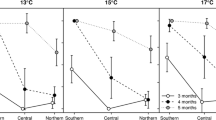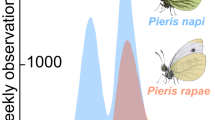Abstract
Because seasonality in tropical habitats is controlled primarily by variations in rainfall rather than variations in temperature, it is frequently less predictable in timing, and spatially more patchy than seasonality in temperate habitats. This constrains the ways in which tropical species can adapt to seasonally adverse conditions, and in particular, may give greater importance to migratory behaviour as a component of seasonal adaptation.
Australian pierid and nymphalid butterflies illustrate these points. The species studied are present as adults during the dry season. Some undergo a reproductive diapause while others breed continuously. Major seasonal shifts in geographic distribution are a conspicuous feature of their biology, except in species whose reproduction is cued directly by rainfall, or are restricted to less seasonal microhabitats. Reproductive diapause is often associated with aggregation and with non-melanic polyphenism. Reasons for spending the dry season as an adult may include the fact that adult food remains available through the dry season even though larval resources disappear, and an improved capacity for opportunistic dispersal before breeding begins. The use of direct rainfall cues to control diapause may exclude non-migratory species from subtropical or temperate regions.
Résumé
Les changements saisonniers des habitats tropicaux sont controlés principalement par les variations du régime de pluie plutôt que de tempeature; de ce fait, ils sont fréquemment moins prévisibles dans leur minutage, et plus inégaux dans leur distribution spatiale que les habitats tempérés. Ces contraintes affectent la façon dont les espèces tropicales s’adaptent aux conditions saisonnières défavorables et en particulier, soulignent l’importance du comportement migratoire comme trait d’adaptation saisonnier.
Les papillons australiens appartenant aux familles Pieridae et Nymphalidae en fournissent l’illustration. Les espèces étudiées sont présentes à l’age adulte pendant la saison sèche. Certaines entrent dans une diapause reproductrice, alors que d’autres se reproduisent sans interruption.
Les importants changements saisonniers de leur distribution géographique représentent un aspect prépondérant de leur biologie, sauf dans le cas des espèces dont la reproduction est directement couplée au régime de pluie ou dans le cas de celles qui sont limitées a des micro habitats saisonniers. La diapause reproductrice est souvent associée au phénomène d’agrégation et de polyphénisme non mélanique. Les raisons pour lesquelles ces espèces passent la saison sèche à l état adulte sont peut-àtre le fait de la présence de nourriture pour adulte tout au long de la saison sèche, alors que. Les ressources des larves ont disparu, et une plus grande capacité de dispersion opportuniste avant le début de la reproduction. L’utilisation des signaux directement reliés au régime de pluie comme contrôle de la diapause exclut peut-àtre les espèces non migratoires, des régions subtropicales et tempérées.
Les papillons australiens appartenant aux familles Pieridae et Nymphalidae en fournissent l’illustration. Les espèces étudiées sont présentes à l’âge adulte pendant la saison sèche. Certaines entrent dans une diapause reproductrice, alors que d’autres se reproduisent sans interruption.
Les importants changements saisonniers de leur distribution géographique représentent un aspect prépondérant de leur biologie, sauf dans le cas des espèces dont la reproduction est directement couplée au régime de pluie ou dans le cas de celles qui sont limitées a des micro habitats saisonniers. La diapause reproductrice est souvent associée au phénomène d’agrégation et de polyphénisme non mélanique. Les raisons pour lesquelles ces espèces passent la saison sèche à 1 état adulte sont peut-être le fait de la présence de nourriture pour adulte tout au long de la saison sèche, alors que. Les ressources des larves ont disparu, et une plus grande capacité de dispersion opportuniste avant le début de la reproduction. L’utilisation des signaux directement reliés au régime de pluie comme contrôle de la diapause exclut peut-être les espèces non migratoires, des régions subtropicales et tempérées.
Similar content being viewed by others
References
Bucher E. H. (1982) Chaco and Caatinga—South American arid savannas, woodlands, and thickets. In Ecology of Tropical Savannas (Edited by Huntley B. J. and Walker B. H.), pp 48–79. Springer-Verlag Ecological Studies 42, Berlin, Heidelberg, New York.
Buskirk R. E. and Buskirk W. H. (1976) Changes in arthropod abundance in a highland Costa Rican forest. Am. Midl. Nat. 95, 288–298.
Common I. F. B. and Waterhouse D. F. (1981) Butterflies of Australia. Angus and Robertson, Sydney.
Claret J. and Carton Y. (1980) Diapause in a tropical species, Cothonaspis boulardi (parasitic Hymenoptera) Oecologia 45, 32–34.
Critchfield H. J. (1966) General climatology. Prentice-Hall, New Jersey.
Denlinger D. L. (1974) Diapause potential in tropical flesh flies. Nature 259, 223–224.
Denlinger D. L. (1978) The developmental response of flesh flies (Diptera: Sarcophagidae) to tropical season. Oecologia 35, 105–107.
Denlinger D. L. (1980) Seasonal and annual variation of insect abundance in the Nairobi National Park, Kenya. Biotropica 12, 100–106.
Denlinger D. L. (1986) Dormancy in tropical insects. A. Rev. Ent. 31, 239–264.
Frith C. B. and Frith D. W. (1985) Seasonality of insect abundance in an Australian upland tropical rainforest. Aust. J. Ecol. 10, 237–248.
Hayes J. L. (1982) A study of the relationships of diapause phenomena and other life history characters in temperate butterflies. Am. Nat. 120, 160–170.
Janzen D. H. (1973) Sweep samples of tropical foliage insects: effects of season, vegetation types, time of day and insularity. Ecology 54, 687–708.
Janzen D. H. and Schoener T. W. (1968) Differences in insect abundance and diversity between wetter and drier sites during a tropical dry season. Ecology 49, 96–110.
Jones R. E., Rienks J., and Wilson L. (1985) Seasonally and environmentally induced polyphenism in Eurema laeta lineata (Lepidoptera: Pieridae). J. Aust. Ent. Soc. 24, 161–167.
Jones R. E. and Rienks J. (1987) Reproductive seasonality in the tropical genus Eurema. Biotropica 19, 7–16.
Kingsolver J. G. (1983) Ecological significance of flight activity in Colias butterflies: implications for reproductive strategy and population structure. Ecology 64, 546–551.
Kitching R. L. and Zalucki M. P. (1981) Observations on the ecology of Euploea core Corinna (Nymphalidae) with special reference to an overwintering population. J. Lepid. Soc. 35, 106–119.
Lowman M. D. (1982) Seasonal variation in insect abundance among three Australian rainforests, with particular reference to phytophagous types. Aust. J. Ecol. 7, 353–361.
Monteith G. B. (1982) Dry season aggregations of insects in Australian monsoon forests. Mem. Qd Mus. 20, 533–543.
Moore G. J. (1985) The behaviour and ecology of two tropical satyrine butterflies. Honours thesis. James Cook University, Townsville, Qld, Australia.
Moore G. J. (1986) Host plant discrimination in tropical satyrine butterflies. Oecologia 70, 592–595.
Rienks J. H. (1981) Morph determination and ecology of Catopsilia pomona (Lepidoptera: Pieridae). Honours thesis. James Cook University, Townsville, Qld, Australia.
Rienks J. H. (1985) Phenotypic response to photoperiod and temperature in a tropical pierid butterfly. Aust. J. Zool. 33, 837–847.
Roland J. (1982) Melanism and diel activity of alpine Colias (Lepidoptera: Pieridae). Oecologia 53, 214–221.
Scheermeyer E. (1985) Some factors affecting the distribution of Euploea core Corinna (Macleay W. S.) (Lepidoptera: Danainae). Aust. J. Zool. 33, 339–348.
Scheermeyer E. (1986) Overwintering in Australian danaines. Proc. 2nd MONOC Conference (in press).
Watt W. B. (1968) Adaptive significance of pigment polymorphisms in Colias butterflies. I. Variation of melanin pigment in relation to thermoregulation. Evolution 22, 437–458.
Watt W. B. (1969) Adaptive significance of pigment polymorphisms in Colias butterflies. II. Thermoregulation and photoperiodically controlled melanin variation in Colias eurytheme. Proc. Natl. Acad. Sci. U.S.A. 63, 767–774.
Wolda H. (1978a) Seasonal fluctuations in rainfall, food, and abundance of tropical insects. J. Anim. Ecol. 47, 369–381.
Wolda H. (1978b) Fluctuations in abundance of tropical insects. Am. Nat. 112, 1017–1045.
Wolda H. (1980) Seasonality of tropical insects. I. Leaf-hoppers (Homoptera) in Las Cumbres, Panama. J. Anim. Ecol. 49, 277–290.
Wolda H. (1982) Seasonality of Homoptera on Barro Colorado Island. In The Ecology of a Tropical Rainforest: Seasonal Rhythms and Longterm Changes. (Edited by Leigh E. G., Rand A. S. and Windsor D. M.) pp. 319–330. Smithsonian Institute, Washington D.C.
Wolda H. and Denlinger D. L. (1984) Diapause in a large aggregation of a tropical beetle. Ecol. Ent. 9, 217–230.
Author information
Authors and Affiliations
Rights and permissions
About this article
Cite this article
Jones, R.E. Reproductive Strategies for the Seasonal Tropics. Int J Trop Insect Sci 8, 515–521 (1987). https://doi.org/10.1017/S1742758400022566
Received:
Published:
Issue Date:
DOI: https://doi.org/10.1017/S1742758400022566




